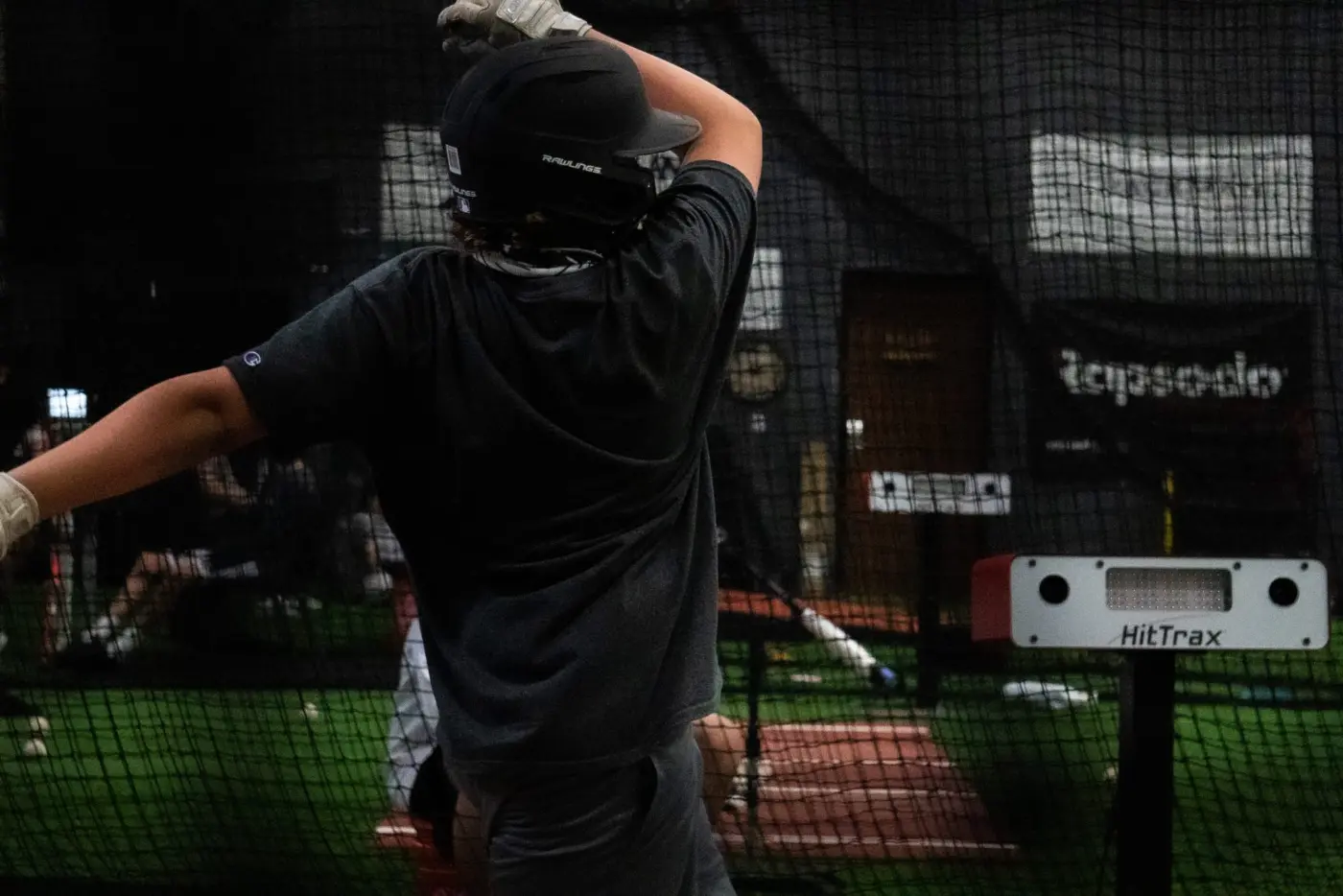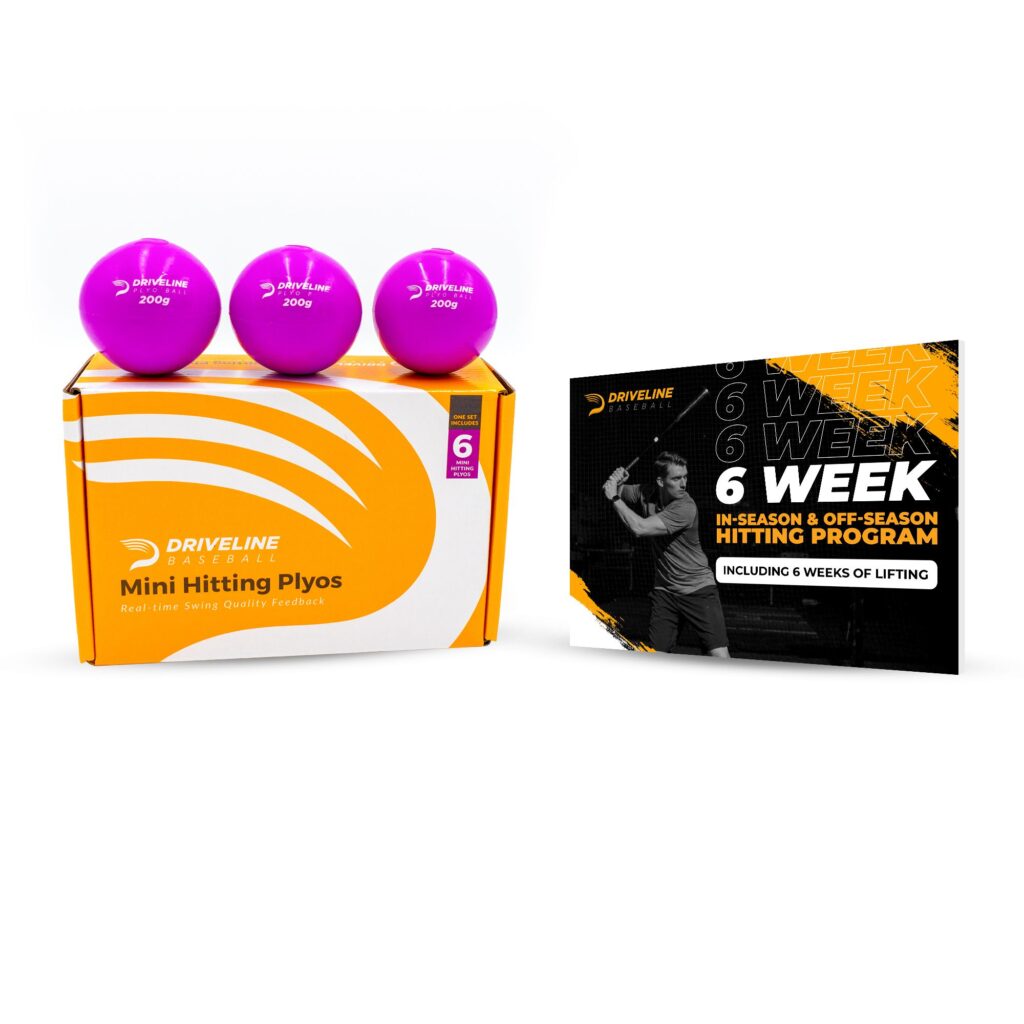7 Great Reasons to Try Weighted Baseballs for Hitting

At Driveline, we use both weighted balls and Plyo Ball ® in our training for both pitchers and hitters. We use weighted baseballs for hitting nearly every day in practice. In this blog we’ll cover:
- The differences between weighted balls for hitting and hitting Plyo Ball ®
- How to use weighted baseballs for hitting
- 7 reasons to use weighted hitting balls
- Bonus hitting drills for bat path
- Free hitting weighted ball program
How are Weighted Baseballs for Hitting Different from Hitting Plyo Ball ®?
Weighted balls are most like baseballs where hitting Plyo Ball ® are soft shell balls filled with sand.
Weighted balls are seam stitched like baseballs and weigh between 3-7 oz. These we do not hit and only use for throwing.
Hitting Plyo Ball ® or hitting weighted balls will be soft shell balls filled with sand, and we have two types. Hitting Plyo Ball ® balls are sand-filled rubber balls of various weights and sizes. Our baseball-sized Plyo Ball ® balls come in 200g, 250g, 300g, and 350g weights. The heavier the ball is, the more perfect you have to be to square it up. Our mini-Plyo Ball ® are smaller versions of our hitting Plyo Ball ® designed to train precision/barrel control and are great for youth athletes.
We’ll refer to them as ‘Weighted Balls’ in this blog for consistency’s sake.
Is it ok to hit weighted balls with composite bat?
Yes. We can’t speak for other weighted balls, our hitting Plyo Ball ® and mini-hitting Plyo Ball ® have been hit daily in our gym since they launch and we’ve had zero issues with cracking or denting bats. Which is why we use them in gym nearly every day.
How to use Weighted Baseballs for Hitting
Our weighted hitting balls are best used off a tee or in front toss. This makes them a great tool for a hitting warm-up or if they are trying to practice hitting at home. For a hitter, you only need to worry about hitting the ball square by trying to hit hard line drives.
Few things are more frustrating for a hitter than getting a good pitch to hit, being on time, and not squaring up the baseball. This is often a wrong path that creates a “clipping” bat-to-ball collision. A proper bat path will make “flush” contact by hitting piercing line drives that carry through the air.
Weighted Hitting balls are the best tool for real-time feedback on your ability to hit a ball square. A perfectly flushed swing will result in a hard-hit weighted ball ball carrying and flying a long distance.
7 Reasons to Use Weighted Baseballs for Hitting
They Give Instant Feedback
You know right away if you hit the ball squarely.

There isn’t any cheating like Wiffle balls where you convince yourself that you hit it square.
Here is a swing of a 12U player hitting a Wiffle ball, does this ball look like it’s hit square?

So let’s slow down the video…

In slo-mo we can see that the hitter is a little early and hits the ball on the end of the bat. Not knowing if you missed the barrel could be detrimental going into a game.
A round of 6-8 swings like this may leave the hitter thinking their swing is on point when we need to look closer at contact.

This ball is a ground ball. We want to prepare our hitters for games and get them feeling good about their swings, but we also want to make sure that the implement we use gives them honest feedback. This is why we prefer weighted balls for hitting practice and warm ups over wiffle balls.
Increase Exit Velocity
Using weighted balls for hitting flips can teach hitters how to properly “square-up” a ball. Learn how to square up a weighted ball, and watch your exit velocities climb when you hit baseballs.
Perfect contact will result in a hitting weighted ball with slight backspin. What makes this tool so effective is that the bat path and contact quality have to be near-perfect to get a good outcome.
Want to cue hitters for better exit velocity using weighted hitting balls?
As a coach, a good cue would be to “hit a knuckleball over my head”. Or tell the hitter to make the ball “compress” around their bat.
A well-hit weighted ball will “float” or “knuckle” at a line drive trajectory.. Hit poorly, and the ball will flatten or “pancake” and spin rapidly in the direction it was mishit.
If you want to provide more objective feedback, you could set up launch angle strings to give the hitter more accurate feedback on their ball flight.
“Ball flight doesn’t lie.” – Joey Votto
Barrel Control
We use mini hitting weighted balls pre-game and practice hitting the ball on the barrel for players of all ages.
Bad Contact:

Good contact:

This player hits the ball flush; as you can see, the ball doesn’t look like a pancake coming off the bat. The feel and trajectory of the weighted ball hitting the bat makes it easier for the player to tell when he’s hit the ball square on the barrel.
Strong Point of Contact
Hitters who do not deliver the barrel with force get physical feedback that allows them to strengthen their point of contact. We want to ensure our hitters are strong at contact and not have their barrel pushed around, especially for youth hitters.
This is why it doesn’t make sense to have youth players hit weighted balls 12 ounces or heavier. It can throw off their barrel and feel of good contact.

The hitter above is hitting a 16-ounce weighted ball square. The ball has a low ball flight and merely makes it past the L-screen.
If you look closely, you will see the weighted ball dictating and manipulating bat path at contact.
We developed our weighted hitting balls to be heavy enough without affecting the player’s bat at contact. We want our players to be strong at contact, not have the ball be so heavy that it pushes the barrel around.
Our weighted hitting balls weigh twelve ounces or less.
Navy Blue: 350g – 12 oz
Royal Blue: 300g – 10.5 oz
Sky blue: 250g – 8.8 oz
White: 200g – 7 oz
Mini Sized: 200g – 7 oz
Not only do you get a variety of ball weights, but these also weigh much closer to the weight of a baseball (5 oz). We recommend the minis for youth players and our full set for high school and older players.

Driveline Mini Hitting Plyo Balls ®
Size: Set of 6
Have a Good Bat Path
Before we can talk about training your bat path with weighted hitting balls, we should answer this question: What is a good bat path?
The bat’s path during the swing is one of the most critical determinants of success in hitting for several reasons. Frequently, hitters waste bat speed by striking the baseball inefficiently. These glancing blows result in mishit batted balls with high spin rate and low exit velocity (think of a lazy fly ball or a line drive that “balloons” and doesn’t carry)

To get the most out of your swing, you want to match the descent angle of the pitch with our attack angle, the better chance we have to make flush contact and increase our smash factor.
In 1971, Ted Williams discussed the idea in his book The Science of Hitting

Descent Angle is the ball’s angle from the pitcher or coach to home plate. There are a lot of factors that affect descent angle, but in general, an MLB fastball has a descent angle between -5°and -7°, sliders between -6° and -8°, and curveballs between -8° and -12°.
So how can we use this information to make flips more productive?
In-gym, we use HitTrax to monitor the descent angles of our flips, looking for a descent angle between -5° and -9°. A coaches release point and velocity will change the descent angle.

Depending on the athlete (think low or high Attack Angle hitters), coaches can manipulate the shape of their flips to drive adaptations. Most flips have too much arch, so the flatter, the better.
Increase Attack Angle by Using Weighted Balls
Athletes who struggle with low attack angles will typically create batted balls with too much backspin, especially if hit at positive launch angles. Let’s use ping pong as an example.

As the bat or paddle works down to contact (negative AA), it catches the bottom of the ball, creating the backspin.
We will often cue guys to try and hit balls with topspin to promote a positive attack angle.
We can also change the training environment to encourage a positive attack angle by adjusting our front toss descent angle. By tossing the ball slower with more arch, we can create a steeper descent angle, which requires the athlete to increase their attack angle to make flush contact.

The athlete intends to match their attack angle with the descent angle of the toss to create flush contact with the weighted ball. The flipper’s goal is to throw the ball high, trying to get it to land on the back of the plate, creating an extremely vertical descent angle.
Making a specific external target, like the top of the cage, allows the athlete to achieve that goal.
Decrease Attack Angle by Using Weighted Balls
Athletes who struggle with high attack angles will demonstrate opposite ball flight characteristics. Typically they will hit balls with a lot of topspin, especially at lower launch angles.

Flips must be tossed with a slight descent angle. Flipping with a little more velo and lowering the release point can help achieve this goal. Once again, we can take this to the extreme with velo at the top of the zone.

The flipper’s goal is to throw the ball at the top of the zone, trying to toss it so that it continuously moves upward. To square up the ball, the athlete will have to lower their attack angle, trying to match the angle of the incoming pitch.
Cueing hitters to hit balls with a lot of backspin will promote a lower attack angle. We can also change the external target to a point lower than usual, like the head of the person flipping.
Bonus Weighted Ball Hitting Drills for Bat Path
Working on attack angle isn’t the only reason to hit weighted balls. Below are a couple of bonus drills that we use to work on other bat path issues.
Can’t Pull the Ball in the Air
These hitters lift up off the ball when they need to make contact out front. This often results in topspin ground balls to the pull side because of a bat path issue late in the swing
One of our favorite drills for this is offset closed with front toss.
Struggle to Hit the Ball Deep
These hitters make contact deep in the zone but the balls are often fouled off or sliced/flared to the opposite field. This is usually from a poor bat path early in the swing.
One of our favorite drills for this is offset open with front toss.
Best Weighted Baseballs for Hitting
Our hitting weighted balls and mini-hitting weighted balls are the best training tools for hitters.
- They’re developed for hitters and been tested at Driveline with hitters that are playing youth baseball to the pros
- Ours are the only hitting weighted balls that come in a variety of weights
- Strong enough to get instant feedback without negatively affecting the barrel at contact
- Our mini-hitting weighted balls are the smallest on the market

Comment section